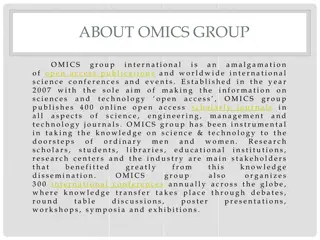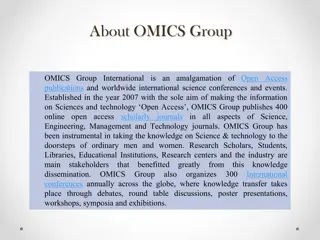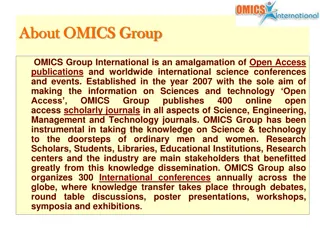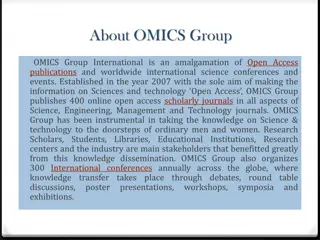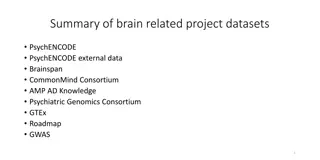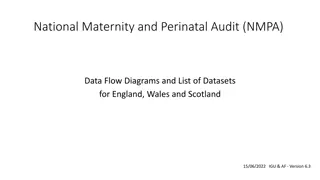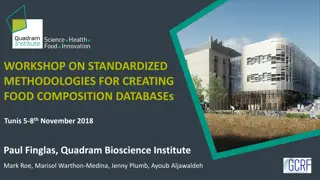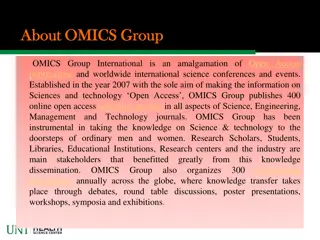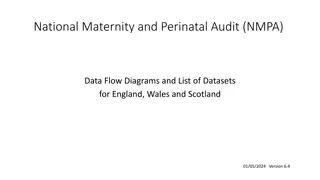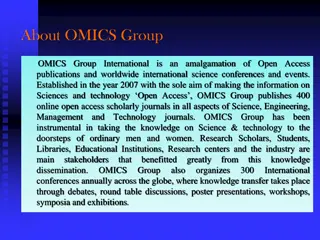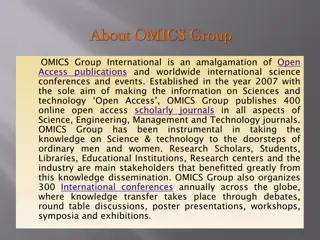Understanding Biological Datasets and Omics Approaches in Disease Research
Explore the world of biological datasets, lipidomics, genomics, epigenomics, proteomics, and the application of omics in studying biological mechanisms, predicting outcomes, and identifying important variables. Dive into DNA, gene expression, methylation, and genetic datasets to unravel the complexities of biology and disease.
Download Presentation

Please find below an Image/Link to download the presentation.
The content on the website is provided AS IS for your information and personal use only. It may not be sold, licensed, or shared on other websites without obtaining consent from the author. Download presentation by click this link. If you encounter any issues during the download, it is possible that the publisher has removed the file from their server.
E N D
Presentation Transcript
Lipidomics etc! Hasin, Y., Seldin, M. & Lusis, A. Multi-omics approaches to disease. Genome Biol 18, 83 (2017). https://doi.org/10.1186/s13059-017-1215-1
Biological Datasets Genomic Epigenomic Biomarker Proteomic
Basic principles of applying -omics Biological mechanisms? Objective measure of health? Predict outcomes? (Direction of causality??) Are any of these associated with my variable of interest? Which are the most important?
C-reactive protein RNA; C-reactive protein gene expression
C-reactive protein gene C-reactive protein RNA; C-reactive protein gene expression C-reactive protein Gene expression
Methylated C-reactive protein gene Less C-reactive protein RNA; Less C-reactive protein gene expression Less C-reactive protein Control of gene expression DNA methylation: Other One of several mechanisms to control Epigenetics mechanisms gene expression DNA Other methylation mechanisms
Person A Possible genotypes: AA AG GG Person B Anna Dearman
Genetics DNA from blood cells Genotype for Person A Genotype for Person B Genotype for Person C SNP ID Chromosome DNA base Variant 1 Variant 2 rs3645 1 3 A T AA AA AA rs780978 1 46 C G CG CC CC rs15674 1 500 G C CC GC GC rs585678 1 729 T A TA TA TA rs1344534 1 1001 A T AT AT AT rs1357435 1 1702 A C AA AA AA rs453536 1 2064 C G CG CC GG rs36456 1 2617 T A AA AA AA rs7801578 1 2662 G A GG GG GG rs815674 1 3185 G C GC GC GC rs594678 1 7659 A T AT AA AT rs1454534 1 11288 T A TT TA TT rs173645 1 12681 T G TT TT TG 500,000 variants 10,000 participants
Genetics DNA from blood cells Genotype for Person A Genotype for Person B Genotype for Person C SNP ID Chromosome DNA base Variant 1 Variant 2 rs3645 1 3 A T 2 2 2 rs780978 1 46 C G 1 2 2 rs15674 1 500 G C 0 1 1 rs585678 1 729 T A 1 1 1 rs1344534 1 1001 A T 1 1 1 rs1357435 1 1702 A C 2 2 2 rs453536 1 2064 C G 1 2 0 rs36456 1 2617 T A 0 0 0 rs7801578 1 2662 G A 2 2 2 rs815674 1 3185 G C 1 1 1 rs594678 1 7659 A T 1 2 1 rs1454534 1 11288 T A 2 1 2 rs173645 1 12681 T G 2 2 1 500,000 variants 10,000 participants
Genetics Genetic factors Genome-wide association studies (GWAS) Polygenic scores Body mass index Educational attainment Testosterone level Personality traits etc Outcomes
Polygenic scores DNA from blood cells Polygenic score for Person A Polygenic score for Person B Polygenic score for Person C PGS Body Mass Index PGS Testosterone PGS 5.0 6.3 7.7 7.8 4.1 3.2 2 polygenic scores (for now)
Person A White blood cells DNA Person B Anna Dearman
Person A 100% methylation White blood cells DNA Person B 50% methylation Anna Dearman
Epigenetics Methylated DNA from blood cells DNA position Methylation % for Person A Methylation % for Person B Methylation % for Person C CpG ID Chromosome cg3645 1 3 0.35 0.05 0.21 cg780978 1 46 0.62 0.02 0.55 cg15674 1 500 0.64 0.84 0.45 cg585678 1 729 0.98 0.64 0.45 cg1344534 1 1001 0.26 0.24 0.18 cg1357435 1 1702 0.37 0.84 0.16 cg453536 1 2064 0.83 0.18 0.92 cg36456 1 2617 0.50 0.18 0.17 cg7801578 1 2662 0.94 0.16 0.39 cg815674 1 3185 0.96 0.81 0.20 cg594678 1 7659 0.92 0.04 0.67 cg1454534 1 11288 0.67 0.22 0.05 cg173645 1 12681 0.22 0.83 0.86 850,000 methylation sites 3,650 participants
Epigenetics Exposures Epigenome-wide association studies (EWAS) exposures outcomes DNA methylation signatures/scores Biological ageing (epigenetic clocks) Smoking Inflammation etc Epigenetic factors Outcomes
Epigenetic clocks Methylated DNA from blood cells Epigenetic age for Person A Epigenetic age for Person B Epigenetic age for Person C Clock Horvath 2013 43 81 78 Hannum 44 82 79 PhenoAge 42 80 77 Horvath skin & blood 40 79 75 Lin 43 81 78 5 epigenetic clocks 3,650 participants
Biomarkers 21 biomolecules that are routinely used in hospital blood tests plasma Includes measures of fat in the blood diabetes inflammation and the immune system anaemia (e.g. haemoglobin) liver and kidney function hormones (e.g. testosterone) serum blood 13,000 participants Non-blood biomarkers Lung function, grip strength, BMI, etc
Biomarkers Exposures Associations between biomarkers and exposures outcomes Allostatic load index Metabolic syndrome index Frailty index etc Bio markers Outcomes
Person A More protein Clotted blood Serum Person B Less protein
Proteomics Protein from serum Abundance for Person A Abundance for Person B Abundance for Person C Protein ANG 0.7 4.6 5.0 ANGPTL3 3.7 2.7 0.1 AOC3 2.5 1.6 1.5 APOM 5.8 1.3 3.0 C1QTNF1 1.9 0.4 3.2 C2 3.5 3.3 2.6 CA1 0.5 0.3 2.6 CA3 2.6 1.5 5.8 CA4 3.8 1.1 4.7 CCL14 3.4 0.2 2.5 CCL18 2.9 0.9 0.8 CCL5 1.1 3.5 5.1 CD46 4.7 4.0 4.7 184 proteins 6,180 participants
Proteomics Exposures Associations between protein levels and exposures outcomes Protein signatures Proteins Outcomes
https://doi.org/10.1038/s41598-020-79429-1 https://doi.org/10.3389/fpubh.2020.00422 https://doi.org/10.1038/nature05526 https://doi.org/10.1038/s41467-019-14161-7







